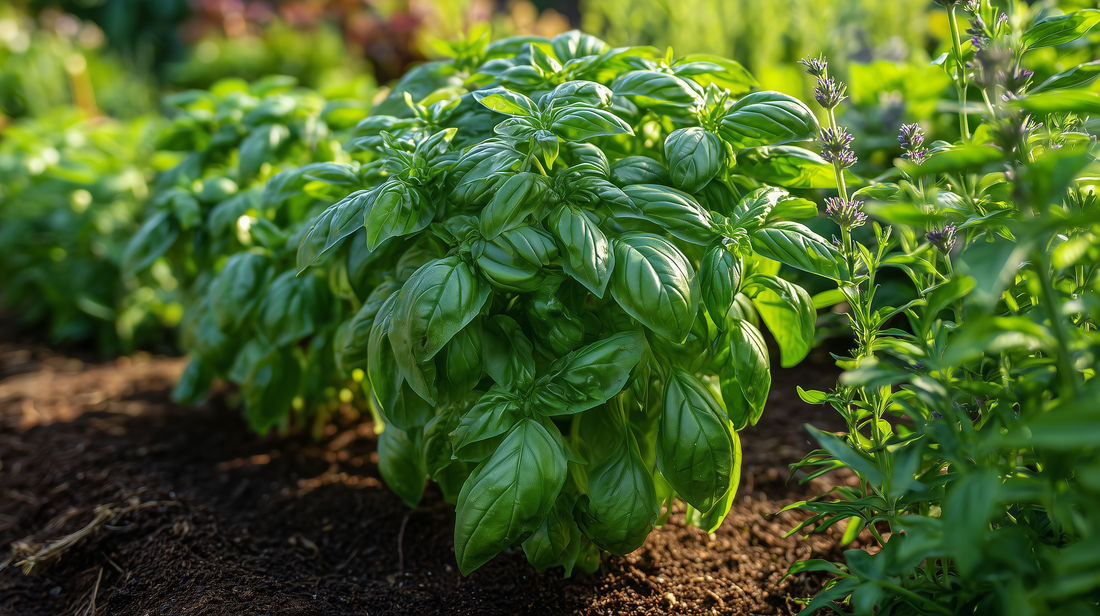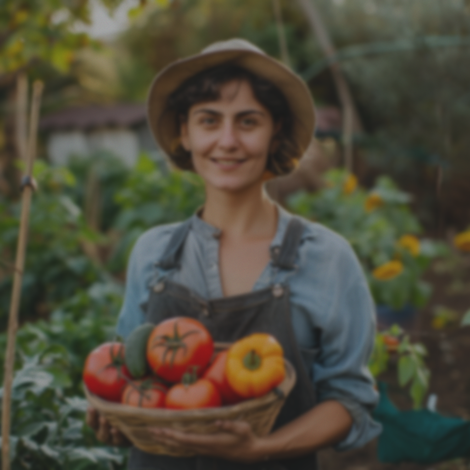ITALIAN, GENOVESE BASIL
ABOUT THE PLANT:
Description: This sweet basil is the main type of basil used in traditional Italian cuisine. It is a bushy herb reaching a height of up to 18 inches. Its leaves have a sweet, spicy flavor. The large leaves are bright green, slightly crinkled, and can grow up to 3 inches long. Small white/pinkish flowers are arranged in a spike and can also be eaten. The flowers are much stronger than the leaves so should be used sparingly.
Origin: Although we associate the 'Genovese' type with Italy, the species actually originated in areas of Asia and Africa and made its way to the Mediterranean via the ancient spice routes
Usage: It is the main type of basil used in traditional Italian dishes such as tomato-based sauces, soups, garnishes, and fresh salads. It is the main ingredient in the ever-favorite ‘pesto’ sauce. Used fresh as a topping on Margherita pizzas.
Interesting facts: Folks use to plant basil in window boxes to keep flies out. It contains Vitamin A, Vitamin K, Iron, Manganese, Calcium, and essential oils.
HOW TO GROW:
General requirements: Basil is heat-loving and prefers warm weather, without the threat of frost. Plant in warm, rich, loose, and well-draining soil. Keep the soil moist, but not soggy. Plant in full sun. Prune the plant as it grows to ensure healthy development. To prune the plant, remove the top few leaves on each stem, carefully leaving at least three sets of leaves on the bottom of each stem. In regions with a short growing season, you can plant seeds indoors 3-4 weeks before the last frost date. Also does well in containers.
In the garden: Seed directly after the last frost when the soil temperature reaches 65-70 degrees F and when nighttime temperatures do not go below 50 F. Enrich the soil before planting with some compost or well-aged manure instead of fertilizing later. Keep the soil moist, but not soggy. Sow seeds at a depth of 1/4 inch or less. Space 1 inch apart. Germinates in 5-10 days. Thin to 12-15 inches apart after 2 or 3 sets of true leaves appear. This herb prefers full sun, at least six hours or more of direct sunlight each day. Although it can survive in partial sun, the herb grows leggier and produces fewer leaves in lower light conditions. Pinch stems back to encourage bushier growth. You can easily do this any time you need a few leaves. Just cut them off right above a leaf node and the plant will send out new branches.
In containers: Choose well-draining containers and use commercial potting soil. Plant seeds at a depth of 1/4 inch or less, 4-6 seeds per pot depending on the size of the container. Place in a warm sunny window. Germinates in 5-10 days. Later thin to 2-3 per pot. If containers are to be placed outside, do so after daytime temperatures reach 65 degrees F or warmer and nighttime temperatures do not go below 50 degrees F. Place in full sun for at least 6-8 hours.
Transplanting: Basil seeds are tiny so it will be easier to start them in a nursery flat and transplant them later. Use commercial seed starting soil and scatter the basil seeds across the surface. Cover them with a 1/4-inch or less layer of soil, firm the soil with your hand, then gently mist. Basil seeds germinate best at 65-70 degrees F with bright light. Place the nursery flat near a bright window and on a seed propagation heat mat if you have one. Once the seeds have germinated, remove the heat mat. Thin them to 2-3 inches apart once true leaves have appeared and wait until 2 or 3 sets of true leaves have appeared before transplanting.
Basil must be hardened off, or acclimated before moving them to a permanent place outside. Wait until daytime temperatures have reached 65 degrees F with nighttime temperatures not going below 50 degrees F. Place the flat in an area that is sheltered from sun and wind for a few hours each day. Gradually increase the amount of sunlight they receive each day. This may take a week or so before they can tolerate the midday sun. Also, decrease the amount of water they receive...the goal is to let the soil dry out a little beneath the surface without the plant wilting. Finally, place the flat in the garden in the spot where they will be transplanted and leave it for 2 or 3 days and nights. Handle the plants gently when transplanting as they are tender and bruise easily. Transplant the seedlings during the cool morning hours, spacing them 12-15 inches apart keeping them at the same depth they grew in the nursery flat. Water well to settle the soil around the roots.
HARVESTING:
Leaves: It is best to harvest the leaves in the cooler part of the morning when the fragrance and flavor will be at their peak. Cut the amount of stem and leaves that you want just above a set of leaf nodes, but do not cut more than 1/3 of the entire plant. Always harvest leaves before the onset of flowering, otherwise, the flavor becomes more and more bitter.
You can store fresh basil that you are not using immediately by placing the freshly cut stems in a container of water and setting it on a kitchen counter for a couple of days. Best not to store it in the refrigerator as the leaves will turn black.
You can store basil for later use by drying or freezing it, but freezing retains the fresh taste better. To dry, tie several stem bunches together and hang them upside down in a cool, dark, and well-ventilated area. Once dry, you can strip the leaves from the stem and store them in a plastic storage container. It will keep for around a year. To freeze for later use, strip the leaves from the stems and place them in a food processor. They will turn dark due to the bruising but will retain flavor. Chop them briefly then add a little water or oil to the mixture. Pour the mixture into ice cube trays and freeze. This method will provide convenient individual servings for future use. It will keep for around a year.
Seeds: Seeds will develop when the flowers have faded. Collect the spikes of flower heads after they have turned brown and dry by snipping them with scissors and drying them further in a protected area away from direct sunlight. Thresh the heads into a bag to remove the seeds. Separate the seeds from debris with a mesh screen. Store seeds in a cool, dry place.
FAST FACTS:
Common name: Italian basil, Genovese basil, sweet basil
Latin name: Ocimum basilicum cv. Genovese
Growth habit: Soft bushy herb reaching a height of 18 inches with large, slightly crinkled light green leaves on a square stem
USDA Zones: Perennial in zones 11-12; annual in others.
Seeds per ounce: 15,000-21,000








